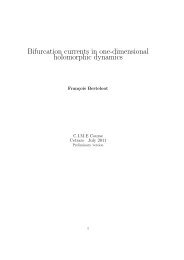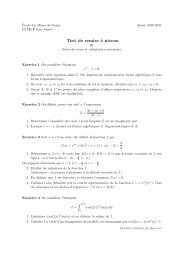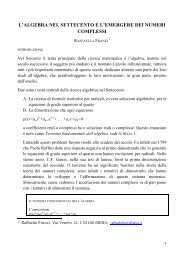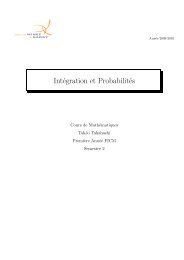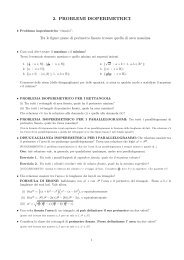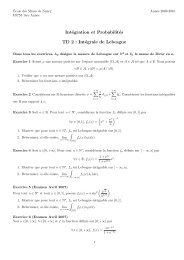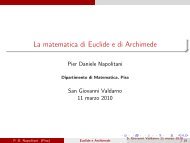Derivation of a fundamental diagram for urban traffic flow
Derivation of a fundamental diagram for urban traffic flow
Derivation of a fundamental diagram for urban traffic flow
You also want an ePaper? Increase the reach of your titles
YUMPU automatically turns print PDFs into web optimized ePapers that Google loves.
2 The European Physical Journal B<br />
density-based approach by Daganzo et al., we will pursue<br />
an alternative, utilization-based approach. This is common<br />
in queueing theory [39] and transportation planning,<br />
where <strong>for</strong>mulas such as the capacity constraint function<br />
(1) areused.<br />
After discussing elementary relationships <strong>for</strong> cyclically<br />
signalized intersections <strong>of</strong> <strong>urban</strong> road networks in Section<br />
2, we will start in Section 3 with the discussion <strong>of</strong><br />
undersaturated <strong>traffic</strong> conditions and derive a relationship<br />
<strong>for</strong> the average travel time as a function <strong>of</strong> the utilization<br />
or the number <strong>of</strong> delayed vehicles. Furthermore, we will<br />
determine a <strong>for</strong>mula <strong>for</strong> the average speed. In Section 4,<br />
we will extend the analysis to congested road conditions,<br />
where the intersection capacity is exceeded. Afterwards,<br />
in Section 5, we will indicate how to deal with oversaturated<br />
networks, where the link capacity is insufficient to<br />
take up all vehicles that would like to enter a road section.<br />
Finally, Section 6 provides a summary and discussion.<br />
In particularly, we will address issues regarding the<br />
transfer <strong>of</strong> link-based <strong>fundamental</strong> <strong>diagram</strong>s to <strong>urban</strong> areas.<br />
We also try to connect the density-based <strong>fundamental</strong><br />
<strong>diagram</strong> <strong>of</strong> Daganzo et al. with the utilization-based approach<br />
developed here.<br />
2 Elementary relationships <strong>for</strong> cyclically<br />
operated intersections<br />
Let us study a single intersection with a periodically operated<br />
<strong>traffic</strong> light. We shall have green phases j <strong>of</strong> duration<br />
ΔT j , during which one or several <strong>of</strong> the <strong>traffic</strong> streams i<br />
are served. β ij shallbe1,if<strong>traffic</strong>streami is served by<br />
green phase j, otherwiseβ ij =0.Thesetuptimeafter<br />
phase j shall require a time period τ j . It may be imagined<br />
to correspond to the time period <strong>of</strong> the amber light (although<br />
in practice, this has to be corrected <strong>for</strong> reaction<br />
times and intersection clearing times). The sum <strong>of</strong> setup<br />
times will be called the “lost service time”<br />
T los = ∑ j<br />
τ j , (2)<br />
while the sum <strong>of</strong> all green time periods and setup times<br />
will be called the “cycle time”<br />
T cyc = ∑ j<br />
(ΔT j + τ j )=T los + ∑ j<br />
ΔT j . (3)<br />
The green times are also sometimes expressed as fractions<br />
f j ≥ 0 <strong>of</strong> the cycle time, i.e.<br />
ΔT j = f j T cyc (4)<br />
with ∑ j f j < 1. After inserting this into equation (3) and<br />
rearranging terms, we get<br />
T los<br />
T cyc ({f j })=<br />
1 − ∑ j f , (5)<br />
j<br />
i.e. the cycle time is proportional to the lost service time<br />
T los .<br />
Assuming average in<strong>flow</strong>s A i per lane, the number <strong>of</strong><br />
vehicles belonging to <strong>traffic</strong> stream i, which must be served<br />
within one cycle time T cyc , amounts to A i T cyc .Inorder<br />
to avoid the <strong>for</strong>mation <strong>of</strong> growing queues (i.e. the onset <strong>of</strong><br />
congestion), the number <strong>of</strong> served vehicles per cycle time<br />
and lane must reach this value. The number <strong>of</strong> vehicles <strong>of</strong><br />
<strong>traffic</strong> stream i potentially served during the green phases<br />
ΔT j is given by ∑ j Q ijβ ij ΔT j per lane, where Q ij denotes<br />
the out<strong>flow</strong> capacity (discharge <strong>flow</strong>) per lane, when<br />
stream i is served by phase j. If we want to have a certain<br />
amount <strong>of</strong> excess capacity to cope with a variability <strong>of</strong> the<br />
in<strong>flow</strong>s, we may demand<br />
(1 + δ i )A i T cyc = ∑ j<br />
Q ij β ij ΔT j = ∑ j<br />
Q ij β ij f j T cyc (6)<br />
with δ i > 0. This linear set <strong>of</strong> equations may be solved<br />
<strong>for</strong> the green time fractions f j . In the following, we will<br />
assume the case, where not several <strong>traffic</strong> streams i are<br />
served in parallel by one and the same green phase, but<br />
where each phase j serves a single <strong>traffic</strong> stream i. Then,<br />
we may assume β ij =1,ifj = i, andβ ij =0otherwise.<br />
Furthermore, Q ij = Q ii = ̂Q i . With this, equation (6)<br />
implies<br />
f i (u i ,δ i )=(1+δ i ) A i<br />
̂Q i<br />
=(1+δ i )u i , (7)<br />
where<br />
u i = A i<br />
(8)<br />
̂Q i<br />
is called the utilization <strong>of</strong> the service or out<strong>flow</strong> capacity<br />
̂Q i (see Fig. 1). δ i ≥ 0 is a safety factor to cope with<br />
variations in the arrival <strong>flow</strong> (in<strong>flow</strong>) A i . According to<br />
equation (5) wemusthave<br />
0 < 1 − ∑ i<br />
f i =1− ∑ i<br />
(1 + δ i ) A i<br />
̂Q i<br />
. (9)<br />
Otherwise, we will have growing vehicle queues from one<br />
signal cycle to the next, corresponding to the congested<br />
<strong>traffic</strong> regime.<br />
Note that, at time t, thenumberN i (t) <strong>of</strong> vehicles per<br />
lane in the road section reserved <strong>for</strong> <strong>traffic</strong> stream i is<br />
given by the time integral <strong>of</strong> the arrival <strong>flow</strong> A i (t) minus<br />
the departure <strong>flow</strong> γ i (t)O i (t):<br />
∫ t<br />
N i (t) = dt ′[ ]<br />
A i (t ′ ) − γ i (t ′ )O i (t ′ ) . (10)<br />
t 0<br />
Here, the starting time t 0 must be properly chosen to give<br />
the correct initial number <strong>of</strong> vehicles on road section i.<br />
During the amber and red time periods, we set the permeability<br />
γ i (t) = 0, as there is no out<strong>flow</strong>, while γ i (t) =1<br />
during green phases. The departure <strong>flow</strong> O i per lane is<br />
given by the service capacity ̂Q i per lane, as long as there



